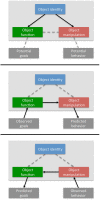The affordance-matching hypothesis: how objects guide action understanding and prediction
- PMID: 24860468
- PMCID: PMC4026748
- DOI: 10.3389/fnhum.2014.00254
The affordance-matching hypothesis: how objects guide action understanding and prediction
Abstract
Action understanding lies at the heart of social interaction. Prior research has often conceptualized this capacity in terms of a motoric matching of observed actions to an action in one's motor repertoire, but has ignored the role of object information. In this manuscript, we set out an alternative conception of intention understanding, which places the role of objects as central to our observation and comprehension of the actions of others. We outline the current understanding of the interconnectedness of action and object knowledge, demonstrating how both rely heavily on the other. We then propose a novel framework, the affordance-matching hypothesis, which incorporates these findings into a simple model of action understanding, in which object knowledge-what an object is for and how it is used-can inform and constrain both action interpretation and prediction. We will review recent empirical evidence that supports such an object-based view of action understanding and we relate the affordance matching hypothesis to recent proposals that have re-conceptualized the role of mirror neurons in action understanding.
Keywords: action prediction; action understanding; affordances; object function; object manipulation.
Figures


Similar articles
-
The influence of cooperative action intention on object affordance: evidence from the perspective-taking ability of individuals.Psychol Res. 2022 Apr;86(3):757-768. doi: 10.1007/s00426-021-01523-4. Epub 2021 May 19. Psychol Res. 2022. PMID: 34009467
-
Intention Reasoning for User Action Sequences via Fusion of Object Task and Object Action Affordances Based on Dempster-Shafer Theory.Sensors (Basel). 2025 Mar 22;25(7):1992. doi: 10.3390/s25071992. Sensors (Basel). 2025. PMID: 40218505 Free PMC article.
-
Is there any Influence of Variations in Context on Object-Affordance Effects in Schizophrenia? Perception of Property and Goals of Action.Front Psychol. 2016 Oct 5;7:1551. doi: 10.3389/fpsyg.2016.01551. eCollection 2016. Front Psychol. 2016. PMID: 27761127 Free PMC article.
-
Cortical processing of object affordances for self and others' action.Front Psychol. 2014 Jun 17;5:538. doi: 10.3389/fpsyg.2014.00538. eCollection 2014. Front Psychol. 2014. PMID: 24987381 Free PMC article. Review.
-
Action semantics: A unifying conceptual framework for the selective use of multimodal and modality-specific object knowledge.Phys Life Rev. 2014 Jun;11(2):220-50. doi: 10.1016/j.plrev.2013.11.005. Epub 2013 Dec 1. Phys Life Rev. 2014. PMID: 24461373 Review.
Cited by
-
Predicting others' actions from their social contexts.Sci Rep. 2023 Dec 12;13(1):22047. doi: 10.1038/s41598-023-49081-6. Sci Rep. 2023. PMID: 38086897 Free PMC article.
-
The Things You Do: Internal Models of Others' Expected Behaviour Guide Action Observation.PLoS One. 2016 Jul 19;11(7):e0158910. doi: 10.1371/journal.pone.0158910. eCollection 2016. PLoS One. 2016. PMID: 27434265 Free PMC article.
-
The influence of state change on object representations in language comprehension.Mem Cognit. 2020 Apr;48(3):390-399. doi: 10.3758/s13421-019-00977-7. Mem Cognit. 2020. PMID: 31625060
-
Do already grasped objects activate motor affordances?Psychol Res. 2019 Oct;83(7):1363-1374. doi: 10.1007/s00426-018-1004-9. Epub 2018 Apr 7. Psychol Res. 2019. PMID: 29627857
-
One step ahead: The perceived kinematics of others' actions are biased toward expected goals.J Exp Psychol Gen. 2016 Jan;145(1):1-7. doi: 10.1037/xge0000126. Epub 2015 Nov 23. J Exp Psychol Gen. 2016. PMID: 26595838 Free PMC article.
References
LinkOut - more resources
Full Text Sources
Other Literature Sources

